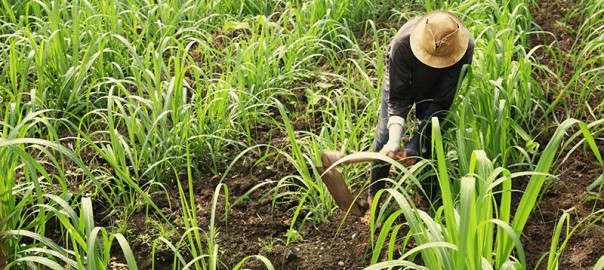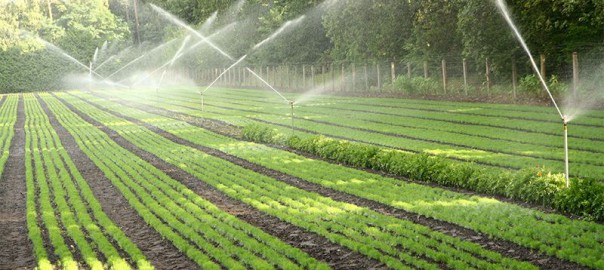Bulletin No 060609 BIOGARDEN BIOLOGICAL CONTROL
The conversion period from conventional agricultural to organic agriculture is one year, as established by IFOAM. But, where to begin? There are various standards and prohibitions to protect consumers, but which are of little help for farmers. Their soils, often appear to be in poor conditions.
The certifiers cannot help, since they only certify if agrochemicals are used or not. Additionally, the do not know how to evaluate the conditions of the soil. However, organic agriculture, and any agriculture with decent profits for that matter, begin with the soil. The basis of agriculture is the dynamic balance between the soil-air-water-nutritious minerals – organic matter-roots-plants-climate. Organic matter, such as dead roots or leaves, are the food for the soils´ life, as microbes and small animals. They contribute to the aggregation of the soil and the pores formation, which enable the penetration of air and water, and contribute to the abundant development of roots. Without air, aerobic life cannot exist in the soil, and an active metabolism of plants is impossible. Without water in the soil, deserts are produced. Here, water drips and the wind carries the rest. Without abundant roots, healthy plants cannot exist. Diseased plants need a lot of agro-toxins, or they transform very little light energy into chemical energy, which means organic substances which we use as food.
For the soil to remain in good condition, plants fuel it with organic matter in the form of dead roots, leaves. A healthy soil does not form clods in the surface when it is ploughed, it does not have scabs on its surface, or (pans) with a shallow depth. Healthy soil is loose and lumpy. Under humid tropical climates, the intensity of life of the soil and the growth of plants is huge. Since the climate influences the plants, the vegetation influences the climate. Clean soils – whether due to the mechanical or chemical elimination of weeds – enable a very strong heating of the air, which rises very quickly. Dust storms may even be generated. In deserts, rain is very scarce because the warm air pushes the clouds upwards, which cross without leaving any water. The contrary occurs in the Amazon, almost 80% of the rains come from local recycling. The water transpired by the trees creates clouds. And since above the forest, during warm hours, there is an (air hole), almost a vacuum, the clouds fall. It always rains at the same time, between two and four in the afternoon. Therefore, the local climate depends on the soil and its vegetable layer, to the same extent in which it depends on the sun and, even, the stars. The productivity of crops as well as the microclimate depend on the treatment of the soil.
But, how to treat the soil? What is the baseline?
There are 7 points which may guide farmers.
1. Provide to the surface of the soil organic matter such as organic matter or stubble. Organic matter is the food of life for the soil, especially for the aerobic life which forms pores. In very poor soils, the organic matter must be fertilized with calcium phosphate such as bone-meal, Thomas slag, hyper-phosphate or something similar in order to nourish microbes in an adequate manner. After the decomposition of the organic matters, the mineral nutrients are released towards the plants. In regions in which the decomposition is too slow, compost is required. In places in which the decomposition is fast, stubble or straw may be placed on the field. Lumpy soil does not require providing plants with all the nutrients which they need and may require in terms of compost no more than 40 t/ha.
In these conditions, plants are able to stock up from the soil. But in compact and hard soil only the nutrients provided are available for the plant. The organic matter must never be buried. The pores are required at the surface.
2. Always keep the pores on the surface of the soil. Therefore the must never be dug too deep. Direct sowing and minimal cultivation are the most adequate methods.
3. Protecting the porous surface of the soil against the impact of rain. This protection is performed through mulch or through less spacious, denser planting. A cover crop or cover cultivation may also be employed, planting, for example, cotton with clovers. Others use weeds as cover, they only cut them and plant vegetables such as lettuce or broccoli.
4. Keep the life of the soil as diversified as possible. Monocultures breed diseases and plagues. The rotation of crops is important. Green manure and associated crops may be included.
5. Protecting crops from wind, making curtains (windbreaks). They do not need to be trees or bushes. Two rows of corn are windbreaks for beans and vegetables. It is only important that 30% of the wind can cross through.
6. When crops show a deficiency of any type of micronutrient, the resistance of the plant to a disease decreases, the production also decreases and a product is harvested with a low commercial level, for example: boron deficiency in cauliflower or carrots. The micronutrient must be administered preferably in power or stone form, or seaweeds, or desalinated sea water, but if none of these is available, chemical micronutrients may be employed. It is better to have healthy and productive plants than diseased and unproductive plants. Additionally, healthy plants produce a better flavor.
7. The machinery must be employed with a high level of scrutiny, crossing the field as little as possible. The distribution of the compost or the pulverization with sulfur or stone dust, also compacts the soil, especially when it is still wet.



